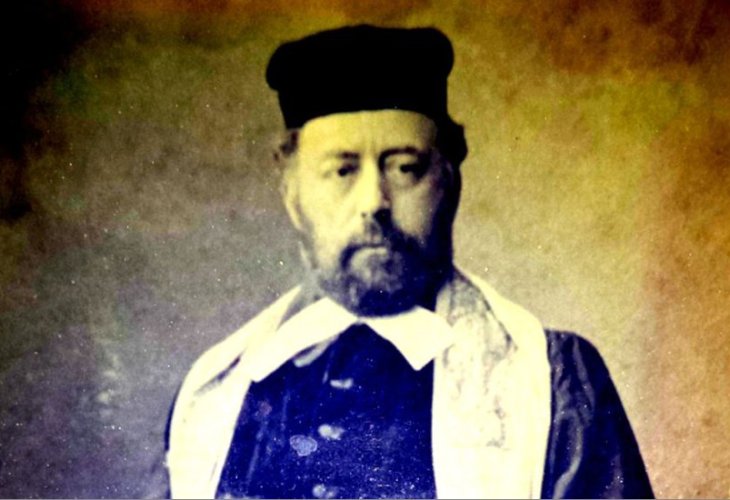Personal Stories
The Prayer Book That Brought Me Back to Judaism
A forgotten siddur led a secular lawyer and his family to embrace Jewish life
- Shira Dabush (Cohen)
- |Updated

Yaron Avraham Greenberg will never forget that moment, twenty years ago, just after the shivah (seven-day mourning period) for his grandmother, Rene, of blessed memory. He was looking through some old cardboard boxes, searching for his grandfather’s Bar Mitzvah siddur (Jewish prayer book), when he came across something completely unexpected. That moment would quietly begin a spiritual journey that would change his life.
At the time, Greenberg, now 50, a lawyer living in the Krayot area was living a fully secular life. He came from a non-religious family. While he had always felt a spiritual side within himself, his curiosity had focused more on philosophy, Nietzsche, Plato than Torah. Jewish practices like Shabbat, Kiddush, or keeping kosher seemed distant, like part of a world he didn’t belong to.
But then he found the book.
In one of the boxes, mixed among books written in German and destined for the garbage, he saw a siddur with a German title. At first, it didn’t look like anything special. But the moment he picked it up, he couldn’t put it down. He kept turning the pages, feeling something deep and unfamiliar pulling him in.
It turned out to be a German-language prayer book from 1873. It had Hebrew transliteration, meant for someone who didn’t know how to read Hebrew fluently. Inside was a handwritten note from his grandmother: “Here is a prayer book from the Braunschweig community.” Rene Greenberg, née Rilf, had written that her parents were born in Braunschweig. The dedication inside was written by Dr. Yom Tov Gutman Rilf, the community’s rabbi until his passing in 1915.
She added more details. The book had somehow made its way to New York and was passed along by the wife of a nursing home patient to someone who had once been a doctor in a nearby German city. Years later, the doctor, at age 90, sent the book to Rene Greenberg but couldn’t recall who gave it to him. “We’ll never know,” she wrote.
The whole family was amazed by the discovery. For Yaron, this was where something inside him began to awaken. “I kept asking myself: Why did I find this book? What’s the meaning behind this? What should I do with it?” At the time, still completely secular, he considered donating the siddur to a museum.
But something made him hold onto it.
Years passed. Greenberg continued living the same lifestyle he had always known. Then, about four years ago, he met Rabbi Shlomo Ofer and everything began to shift. “When I met the Rabbi, I started a beautiful journey,” he says. “I began putting on tefillin and attending a weekly prayer session called ‘Tikkun.’” Little by little, he began to understand that finding the siddur wasn’t a coincidence. It was part of something much deeper, a personal invitation from Hashem.
From that moment on, he says, he never parted with the prayer book. It went with him everywhere.
“I had been through a few big things in life that made me ask questions with real weight,” he explains. “But I never imagined that coming back to Judaism would become such a major part of who I am.”
As his commitment grew, his wife was supportive. They bought a Shabbat hot plate and an urn for heating water, even though she initially wasn’t ready to take on the changes herself. “She told me, ‘If you want to keep Shabbat, that’s fine. But I’ll keep doing what I’m used to,’” he remembers. “All I had learned about Torah until then was what they teach in secular schools, biblical criticism. But I was thirsty for something more. I started buying seforim (holy books), and that was just the beginning.”
With the help of a rabbi who lived nearby, Greenberg learned how to use a siddur and understand the structure and meaning of the prayers. Later, he learned how to properly observe Shabbat. Slowly, gently, he began to take on more and more mitzvot.
Half a year later, his wife joined him. Together they made big changes: “We put in two sinks, one for dairy and one for meat. We removed all the secular books from the house. And the biggest step of all, we moved our children into religious schools.”
Looking back, Greenberg says, “We clearly had a lot of help from above. But we also had to make our own effort. You can’t just wait for Hashem to do everything for you. You have to take the first step.”
Today, he sets time for Torah learning and studies Gemara every Shabbat.
As a lawyer, doesn’t he miss reading secular books?
“Not at all. The depth and wisdom I’ve discovered in Torah are beyond anything I’ve ever known. I learn with a rabbi and a chavruta (study partner), someone I feel is truly connected to the root of my soul. The more I learn, the more I realize how much I don’t know yet. It’s endless.”
And what if he’s tempted by something from his old life?
“Even if that happens once in a while, I remind myself if Hashem doesn’t want something for me, then I don’t want it either. My will should be aligned with His.”
And to think, it all began with a dusty old prayer book, sitting quietly in a box, waiting to be found.

